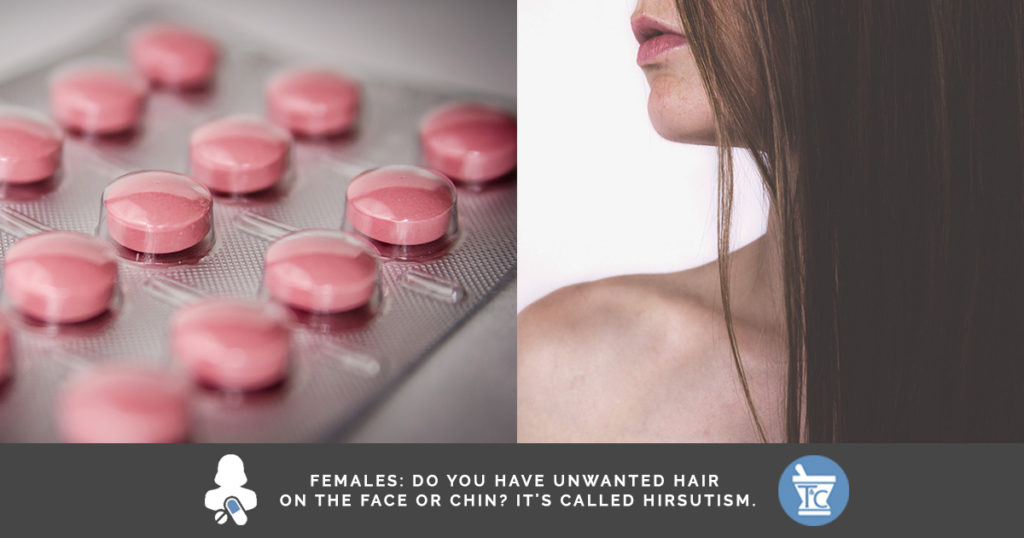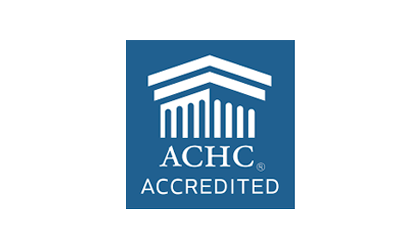What is Hirsutism?
Hirsutism can be defined as excessive body hair in women, often in areas of the body where hair is unwanted.¹
Women who suffer from facial hirsutism often avoid social situations and have been observed to have signs and symptoms of anxiety and depression. This issue presents a need for affordable compounding ideas for patients with undesired facial hair.
The term “Hirsutism” is of Latin origin, meaning excessive growth of stiff hair, or simply hairiness. The common clinical use of the term refers to women with excess growth of stiff, pigmented hair (known as “terminal hair”) in a male pattern. Specific sites for excess hair are lips, chin, and chest. Complaints of unwanted hair on the face or chin are often common complaints we hear from middle-aged women. In approximately 90% of hirsute females, the condition either is caused by an underlying polycystic ovarian syndrome (PCOS) or is idiopathic (of unknown cause).¹ Sometimes women or prescribers think this is caused by an imbalance of hormones as women go through menopause.
At Town & Country Compounding we do our best to work with the patient and the practitioner to offer alternative options for the patients.
Cost-effective Options
Regardless of the source, patients are looking for a cost-effective options for unwanted hair, and even when the commercial product is available, the cost is too prohibitive for many patients. Certainly we should look at balancing the hormones or metabolic disorders, but many times a quick solution is needed. Pharmacists and prescribers thinking outside the box and looking at literature through a different lens can create a new and innovative product to solve patients’ problems.
Unfortunately, commercial products to address hirsutism can be very expensive, and they often come with unwanted side effects. For instance, one common brand of topical cream for the excessive facial hair in women is priced at almost $200 for one 45 Gm tube.³ It’s too bad that laser only works for certain colors of hair and electrolysis is very painful and requires multiple sessions. This leaves many lighter haired women without great options.
One option may be topical metformin. It is well known that metformin reduces circulating androgens, which can decrease the occurrence of excess hair in women. Combining this with new research demonstrating a local effect when applied topically for hyperpigmentation, it’s not too far of a stretch to hypothesize that applying metformin topically may inhibit and reduce terminal hair growth.
Metformin
Metformin is indicated as an off-label option for PCOS because it reduces circulating insulin, which decreases the concentration of free levels of androgens. A few studies have examined the influence of metformin on hirsutism as the primary end point. Kelly and Gordon — in a 14-month, randomized, double-blind, placebo-controlled crossover trial — demonstrated a modest reduction in hirsutism at the end of therapy.¹
Also, a six-month, randomized, controlled trial of 70 patients with PCOS who received metformin along with intense pulse light (IPL) for hair removal, when compared to IPL alone, demonstrated the superiority of the regimen employing metformin in combination with IPL. ⁵
Other evidence comes from dermatological research. Dermatologists have looked at metformin in a number of cutaneous disorders, such as hormonal acne, hidradenitis suppurativa and acanthosis nigricans. Very recently, systemic usage of metformin for psoriasis and cutaneous malignancies has shown promising results. Interestingly, though, topical metformin has also been used in hyperpigmentation disorders. One of the proposed mechanisms for reducing pigmentation involves inhibiting the activity of protein kinase C beta (PKC-β). Another study demonstrated that inhibition of PKC-β activity not only blocked tanning, but reduced basal pigmentation in the epidermis and hair.⁶
Finally, there is promising evidence when looking again at metformin and insulin. Studies of the local effect of metformin on the growth rate of hair at the follicular level have yet to be investigated. However, studies have shown that hair follicles that are exposed to excessive levels of insulin exhibit a higher growth rate. Conversely, hair follicles maintained in the absence of insulin or at typical levels prematurely entered a catagen-like state. The catagen phase is a transitional phase in which the hair follicle shrinks and is cut off from its blood supply. The hair does not grow during this phase, and melanin production stops.⁷
Other Options
This new research and new perspective on topical metformin may be helpful to compounders and patients in combination with some of the more well-known options. Here are some of the common options for these patients:
Progesterone – Progesterone is considered an anti-androgen due to the fact that it competes with androgens for the androgen receptor. Some have suggested that it has an effect on 5-alpha reductase (5-αR) — an enzyme whose main function is converting testosterone to dihydrotestosterone (DHT), a highly active form of testosterone — but the literature does not support this concept. However, if progesterone occupies the androgen receptor, then testosterone or DHT are unable to bind and have an effect.⁸
Azelaic Acid – A prominent theory is that the azelaic acid is responsible for the decreased DHT production, and in fact, it has been shown to inhibit the activity of 5-αR. By suppressing this cycle, hair growth will slow or even stop.⁹
Spironolactone – Spironolactone is an androgen blocker and competes with DHT for binding to the androgen receptor. Studies have also shown spironolactone to have an inhibitory effect on 5-AR. Typically spironolactone is used orally, but it is also used topically to illicit a local effect while minimizing systemic side effects. The downside with a topical preparation is the odor, which is unpleasant and may require the addition of a fragrance.¹⁰
Finasteride compounded cream and combinations
Finasteride is a competitive inhibitor of 5α-reductase.⁴ It is recommended to be taken as second-line option for hirsutism. Based on some guidelines, oral contraceptive pills used as first-line option for hirsutism may be combined with finasteride after six months if therapy response is considered suboptimal. One particular study compared finasteride 0.25% cream to placebo. After six months of therapy, mean hair counts decreased significantly in the finasteride sites compared to no significant change observed in the placebo-applied sites.
Example Formulas to Discuss with your Prescriber
- Metformin HCl 5%/Progesterone 1%/Azelaic Acid 1%/ Spironolactone 5% Topical Cream
- Metformin HCl 5%/Progesterone 1%/Azelaic Acid 1% Topical Cream
- Finasteride 0.25% Facial Cream
If you need any additional information on Hirsutism, or the possible options – Town & Country Compounding Experts can help. Please contact us and we’ll get you on the right track to improve your quality of life.
References
- Yildiz, B. O., Bolour, S., Woods, K., Moore, A., & Azziz, R. (2010). Visually scoring hirsutism. Human Reproduction Update, 16(1), 51-64. https://doi.org/10.1093/humupd/dmp024
- Bubna, A. K. (2016). Metformin – For the dermatologist. Indian Journal of Pharmacology, 48(1), 4-10. https://doi.org/10.4103/0253-7613.174388
- Bristol-Myers Squibb. (2000). Bristol-Myers Squibb Labeling Vaniqa. Retrieved from https://www.accessdata.fda.gov/drugsatfda_docs/label/2000/21145lbl.pdf
- Kelly, C. J., & Gordon, D. (2002). The effect of metformin on hirsutism in polycystic ovary syndrome. European Journal of Endocrinology, 147(2), 217-221. Retrieved from http://www.eje-online.org/content/147/2/217.long
- Rezvanian, H., Adibi, N., Siavash, M., Kachuei, A., Shojaee-Moradie, F., & Asilian, A. (2009). Increased insulin sensitivity by metformin enhances intense-pulsed-light-assisted hair removal in patients with polycystic ovary syndrome. Dermatology, 218(3), 231-236. https://doi.org/10.1159/000187718
- Park, H. Y., Lee, J., González, S., Middelkamp-Hup, M. A., Kapasi, S., Peterson, S., & Gilchrest, B. A. (2004). Topical application of a protein kinase C inhibitor reduces skin and hair pigmentation. Journal of Investigative Dermatology, 122(1), 159-166. https://doi.org/10.1046/j.0022-202X.2003.22134.x
- Philpott, M. P., Sanders, D. A. & Kealey, T. (1994). Effects of insulin and insulin-like growth factors on cultured human hair follicles: IGF-I at physiologic concentrations is an important regulator of hair follicle growth in vitro. Journal of Investigative Dermatology, 102(6), 857-861.
- McCoy, N. L. (2001). Female sexuality during aging. In P. R. Hof & C. V. Mobbs (Eds.), Functional Neurobiology of Aging (pp. 769-779). San Diego, CA: Academic Press.
- Stamatiadis, D., Bulteau-Portois, M. C., & Mowszowicz, I. (1988). Inhibition of 5 alpha-reductase activity in human skin by zinc and azelaic acid. British Journal of Dermatology, 119(5), 627-632.
- Sachdeva, S. (2010). Hirsutism: Evaluation and treatment. Indian Journal of Dermatology, 55(1), 3-7. https://doi.org/10.4103/0019-5154.60342
- Lehraiki, A., Abbe, P., Cerezo, M., Rouaud, F., Regazzetti, C., Chignon-Sicar, B., … Rocchi, S. (2014). Inhibition of melanogenesis by the antidiabetic metformin. Journal of Investigative Dermatology, 134(10), 2589-2597. https://doi.org/10.1038/jid.2014.202
- Compounding Ideas for Patients with Excessive Facial Hair (Hirsutism) By Michael Schmidt, PharmD Candidate 2017, Creighton University Preceptor: Bruce Biundo, RPh, FACA, PCCA Pharmacy Consultant
- Lucas, K. J. (2001). Finasteride cream in hirsutism. Endocrine Practice, 7(1), 5-10. http://dx.doi.org/10.4158/EP.7.1.5






